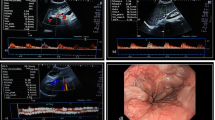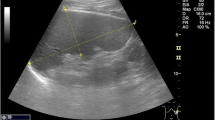Abstract
Background
The relationship between portal and splenic vein hemodynamics, liver function, and esophageal variceal bleeding in patients with cirrhosis remains unclear. The aim of the present study was to investigate quantitative Doppler parameters of splanchnic hemodynamics in cirrhotic patients and to determine the value of the Doppler parameters in predicting esophageal variceal bleeding.
Methods
With the help of pulsed Doppler ultrasonography, we investigated portal and splenic hemodynamics in 18 healthy controls and in 45 patients with liver cirrhosis, in whom the relationship of splenic hemodynamics with esophageal variceal bleeding and the grade of cirrhosis was examined.
Results
Portal flow velocity was decreased in cirrhotic patients with Child’s C cirrhosis, as compared to those with Child’s A cirrhosis (P < 0.001). The portal blood flow volume in Child’s C cirrhosis were also significantly low compared to patients with Child’s A and Child’s B cirrhosis (P < 0.001 and P < 0.05, respectively). There was a significant increase in the portal vein congestion index and splenic vein congestion index in patients with Child’s C cirrhosis as compared to patients with Child’s A cirrhosis (P < 0.001). Among cirrhotic patients, the group with esophageal variceal bleeding had significantly greater splenic blood flow volume and splenic vein congestion index (P < 0.001). Patients with ascites had significantly lower portal flow velocity (P < 0.001) and higher portal vein congestion index and splenic vein congestion index (P = 0.003 and P = 0.05, respectively) as compared to those without ascites.
Conclusions
In this report we have shown that the decrease in blood flow and increased congestion indexes in the portal vein and splenic vein are related to the impairment of liver function in cirrhotic patients; these indexes may be valuable factors for predicting esophageal variceal bleeding.
Similar content being viewed by others
Author information
Authors and Affiliations
Rights and permissions
About this article
Cite this article
Kayacetin, E., Efe, D. & Doğan, C. Portal and splenic hemodynamics in cirrhotic patients: relationship between esophageal variceal bleeding and the severity of hepatic failure. J Gastroenterol 39, 661–667 (2004). https://doi.org/10.1007/s00535-003-1362-x
Received:
Accepted:
Issue Date:
DOI: https://doi.org/10.1007/s00535-003-1362-x




